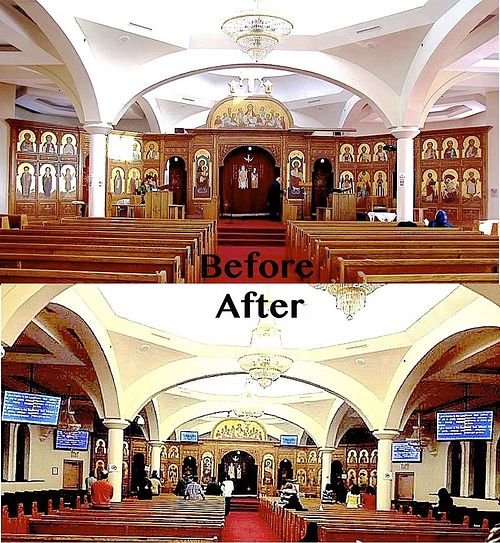Source: The Pearl of Great Price
Ask Samuel L. Jackson, the only thing scarier than 'snakes on a plane,' are projector screens in an Orthodox church! When you think of projector screens being hung above (or even in front of) an iconostasis projecting the liturgical text, your first inclination might be to assume that such use of modernity must obviously be a good thing. Rationally, it would only make sense that this technology would help parishioners "follow along" during a divine liturgy, allowing everyone to be fully engaged in the worship. Makes sense, right? Well, not quite. This well intended addition which has crept its way into our liturgical worship over the past few years may actually be more a hindrance than a help.
Participation in the divine liturgy involves every person in a parish, not just the clergy, and choir - it is to be participated in corporately. Our goal in liturgy is not to mindlessly recite prayers, neither is it to listen to someone else recite the prayers, but rather, it is to experience communion with God and with the body of Christ, that being the Church. The words being prayed and sung should become our words, expressing the groans of our heart. The liturgical text should not be viewed as some magical incantation someone wrote centuries ago that requires a congregation to patiently allow for the prayers to have their desired affect on the gifts placed on the altar, but rather, the liturgical prayers should be internalized, and 'chewed' on by our whole being. Therefore, it is also less important to be caught up trying to 'follow along,' and more important to truly be present in the corporate liturgical dance.
Some might be thinking here, "What about visitors and catechumens? Wouldn't they benefit from a projector screen?" – Great question! Of course all churches should make sure they have books available for new comers. However, making these texts available should be for the express purpose to encourage these individuals to also to participate in the liturgy, the books should never be allowed to be used as a type of distraction from what is happening around them. Imagine for a moment while you are watching a film someone hands you the script to the movie so you can 'follow along' - would it be safe to assume that most people wouldn't find that enjoyable? Imagine all that person would miss! Would you or anyone you know be just as involved in the plot of the film if they were simply reading, neither really watching and/or listening? This is one of the many reasons why musical and theater performances do not hand their patrons the text being used. A person is meant to live the experience, not to 'follow along.'
Typography, by its nature, separates and compartmentalizes information, making it impossible for a complete and rich experience. Applying this observation to reading off a screen while participating in liturgical worship, it comes as no surprise why many complain that liturgical prayers often lack a 'prayerful feel.' And how could such liturgies be prayerful when they are reduced to a 'read-along'?
Delving into this dilemma further, it may be worthwhile examining just how text and typography actually influences our cognition and what affects it may have on our engagement with the world. Canadian communications theorist and philosopher Marshall McLuhan, wrote extensively on the effects of typography and text on individuals and society. According to McLuhan, unlike in times past or in cultures where typography is not considered the primary mode of communication, we in our modern Western culture have significantly lowered our ability to synthesize the world around us. It may be worth mentioning that McLuhan also believed that the invention of print technology and its ontologically disjunctive nature contributed to the rise of individualism, capitalism, and nationalism - all of which could be argued are anti-liturgical ideologies.




